Not every obsolete office building is cut out to become apartments

This former EPA office building was well-suited for adaptive reuse as residences.
This article was first published on November 20, 2017. The pandemic has sparked a lot of conversation about the future of office buildings, so we wanted to share this article again.
Hundreds of functionally obsolete 1980s and 1990s office buildings around Greater Washington are reaching an age where they will require substantial renovation, and will have to be reinvented. Some, but not all, of them can become residences, depending on their location, price, and layout.
In other US cities that boomed in earlier eras, thousands of people live in what were 19th-century industrial lofts, Art Deco office buildings, or even modish 1960s offices. In Baltimore City, for instance, commercial real estate broker JLL says 17 office conversions have replaced 2.8 million square feet of offices with apartments and hotels, spurred on by local and federal tax credits. Similar local incentives created new residential neighborhoods in downtown Los Angeles and New York.
All four buildings in this stretch of South Broadway in Los Angeles were built as offices, but were recently renovated as residential or hotel. Image by the author.
Yet despite considerable media coverage, office conversion has been comparatively limited in the region. JLL counts 26 conversion projects in DC, Montgomery, Arlington, and Fairfax, which have taken a total of 2.9 million square feet of offices off the market. That’s scarcely more than in Baltimore City, despite a supply of office space that’s more than five times larger.
Office-to-residential conversion isn’t as common here for a variety of reasons, including a relatively healthier office market and a lack of specific incentives for the practice (so far.) Residential conversion offers some promise, but will not be a panacea for either the over-supply of offices, or the under-supply of affordable homes, because not every obsolete office building can be converted to housing.
Both Fairfax County and Montgomery County have recently commissioned studies to investigate office building adaptive reuse, and local architect Michael Wiencek (who previously wrote about this topic in GGWash) has assembled a portfolio of local cases. These have noted several considerations that can help understand whether an obsolete office building might be a candidate for conversion to another use. Three key considerations are location, price, and layout.
Plentiful transit and daytime amenities mean the Farragut Square area is still popular with office tenants. Image by Eric Allix Rogers licensed under Creative Commons.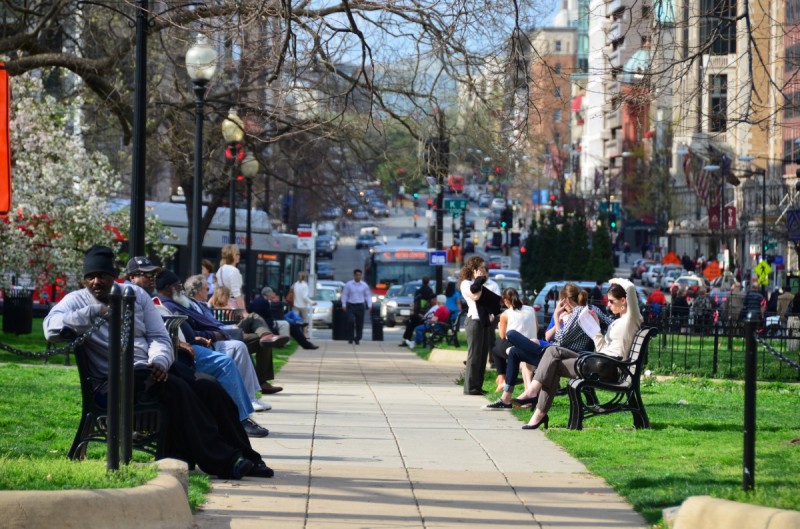
Location
As with any other real estate decision, location is the most important factor in determining whether offices or apartments make sense at a given site.
Some location factors make both offices and residences valuable, but others are specific to each property type. Apartments might be better for a site near schools, ballfields, or libraries. Offices are better suited for a site right next to Metro or highways, lunchtime delis, hotels, courthouses, or clients’ offices — since even a few blocks can make a huge difference for office workers who are squeezing multiple errands into a lunch hour. Many of these denser, lively locations are drawing offices away from more peripheral locations, including the recent relocations of Fannie Mae, Marriott, and General Dynamics.
Office buildings that have been converted to residential in Silver Spring, Hyattsville, Wheaton, Crystal City, Old Town and West End Alexandria, West End, and Southwest Waterfront have been at the edges of those core areas where offices are still in high demand.
Another common theme among those new apartment buildings is that they’re still located within walkable, mixed-use neighborhoods. Yet unlike other regions that have seen substantial office-to-residential conversion, many of Greater Washington’s vacant offices are in “edge city” suburban office campuses that just didn’t pan out.
Another bonus is that it can be easier for a developer to gain public approvals for gut-rehab an office building, compared to renovating existing apartments or building new apartments on vacant land. Reusing existing buildings usually doesn’t stoke NIMBY opposition, offices don’t have tenant protections, and commercial zoning can be more generous than residential.
Some municipalities, like Loudoun County, rely heavily upon the higher property taxes that commercial buildings pay — and as a result might discourage office to residential conversions. So far, this has been less of a concern in the region, particularly because the small apartments that tend to be built through conversions don’t house many public school students (the largest cost for municipal governments.)
Residential conversion still involves a lot of expensive demolition and reconstruction work. Image by the author.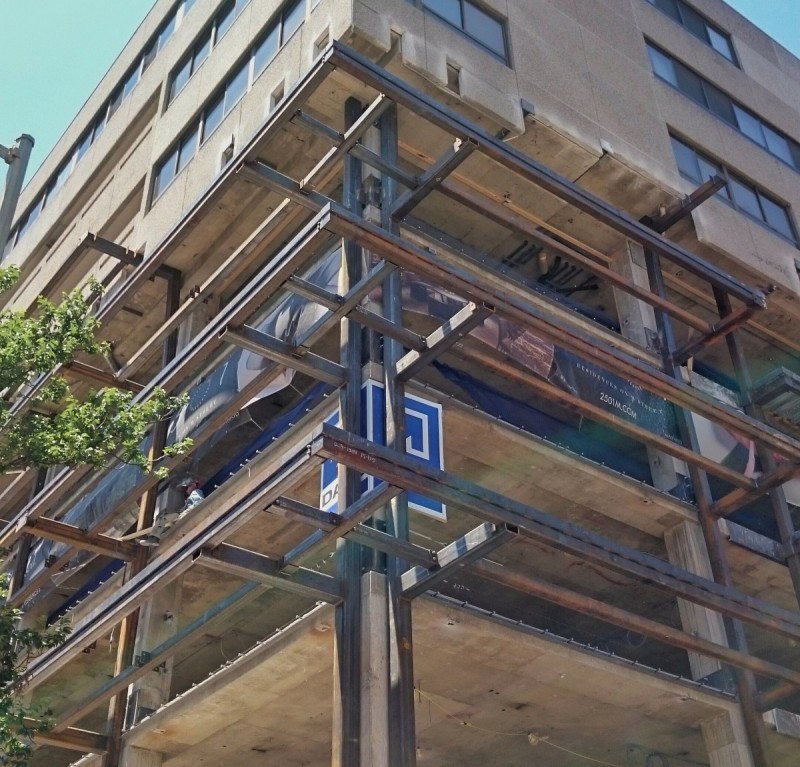
Price
In general, apartments pay less in rent than offices do. In high-demand markets like downtown DC, offices can rent for twice as much as apartments on a per-square-foot basis. But for obsolete office buildings in more marginal office locations, that spread can be much narrower, or even reversed.
Two new floors could be added atop this industrial building at the Yards, because apartments are lighter than its prior commercial use. Image by Daniel Lobo.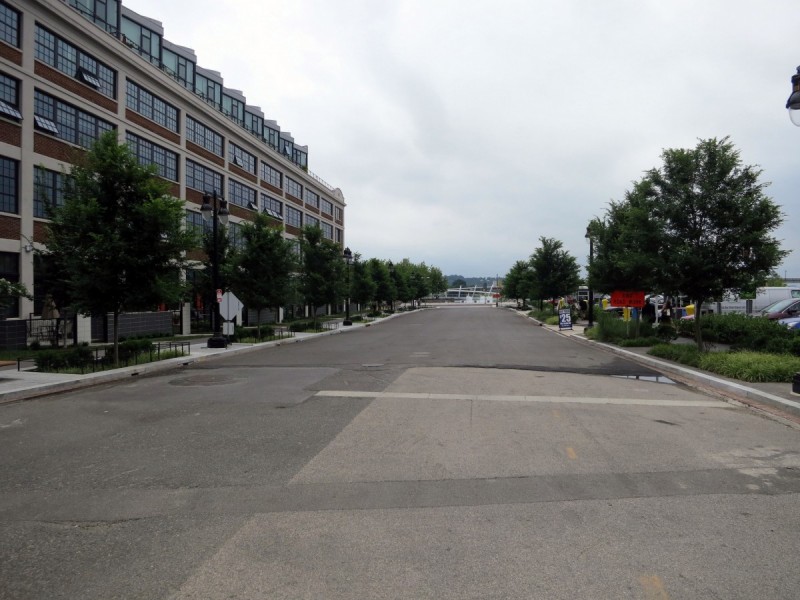
Where an office building can be purchased for a low enough price, conversion to residential can be economically appealing. The building’s structure, elevators, stairs, and parking lots can be reused, saving time and cost for a building’s costliest elements. Since individuals’ apartments are larger than their cubicles, apartments are a lower-density use and require fewer parking spaces, so it can be possible to replace parking lots with new buildings. It may even be possible to add floors atop an existing building, as at a proposed conversion near the Eisenhower Metro, since apartments’ contents are lighter than offices’.
The price has to be substantially discounted, not just equivalent, because residents can’t just move right in. An office building still requires a costly gut renovation, at a cost of perhaps $100,000 per apartment created. Kitchens and bathrooms need to be added, along with the plumbing lines to supply them; electrical and ventilation systems need to be overhauled, dated finishes like drop ceilings and carpet have to be removed; and oftentimes the facade will need to be replaced to improve insulation, views, and ventilation.
Older offices, like the Commerce Department headquarters in Federal Triangle, are much narrower than post-war buildings like the Reagan Building at center. Image by the author.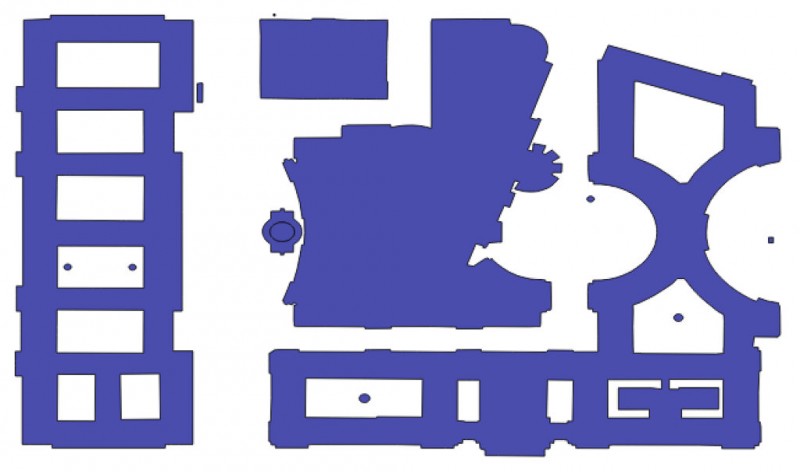
Layout
Buildings that have successfully been converted are comparatively narrow and tall — quite unlike the stereotypical short-and-squat DC office building. Structures built before World War Two usually had plenty of windows for light and ventilation. In the mid-20th century, ubiquitous fluorescent lights and air conditioning allowed commercial buildings to grow much wider, with higher-value space along the windows and cubicles or storerooms in the windowless middle.
Building codes don’t require that every cubicle have a window, but every apartment does need windows. That means that narrower buildings are easier to convert into residences.
Wiencek points to the narrow width of two conversion projects he’s worked on; both structures compare favorably to a typical apartment building width of 65 feet — two 30-foot-deep units on both sides of a five-foot-wide hallway. (Hotel rooms are even less deep.)
Cordell Place in Bethesda is just 35 feet wide, with apartments on one side of the hallway. The Lex and Leo, twin towers in Southwest Waterfront, are 86 feet wide — so their apartments are substantially deeper than usual, with living rooms placed along the windows and “inboard” bedrooms behind. This is possible because, contrary to popular misconception, construction codes here don’t require that bedrooms have their own operable windows. Instead, they can “borrow” light and air from other rooms via a sufficiently large opening — usually a wall that doesn’t reach the ceiling. (The E-lofts building in Alexandria uses a similar approach.)
Some of the few conversions in central DC have been of unusually narrow buildings. For instance, 2501 M St. NW was built as an odd half-condo, half-office hybrid, so changing its offices to condos made sense. (It still wasn’t easy; adding the plumbing required drilling over 2,500 holes into the structural concrete.) The Reporters Building near L’Enfant Plaza is 65 feet wide, and the 1522 K St. NW building (now the Hyatt Place hotel) is just 60 feet wide.
Courtyards can bring a bit of light into very deep buildings’ interiors. Image by the author.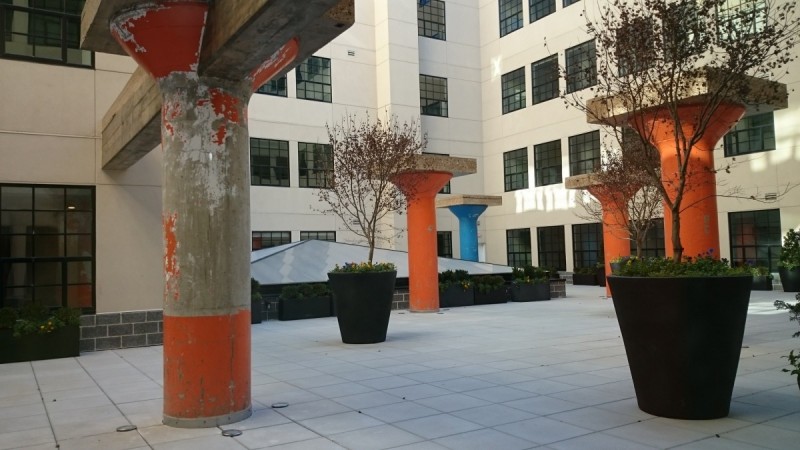
An inexpensive building with an incredibly deep footprint, like the nearly 350-foot-deep Hecht Warehouse in Ivy City, can be converted into usable residences by cutting out courtyards within the building. But a typical office building has its key services — like elevators, staircases, and pipes — right in the middle. Cutting these out would wipe out any cost advantage of retaining the structure.
What about the rest?
Overlaying all of these considerations considerably narrows the universe of office buildings that make sense as residences. Of the thousands of office structures in Fairfax County, only a few dozen fit what the county thought were size, age, location, and layout criteria that made them appropriate for residential.
Some office buildings just aren’t suited for either residential conversion or for continued use as offices. Deep footprints aren’t as efficient as they once seemed. It turns out that office workers like windows too, and companies no longer need the file storage rooms that once filled dark interior spaces.
Image by Josh Meister Photo for Fairfax County.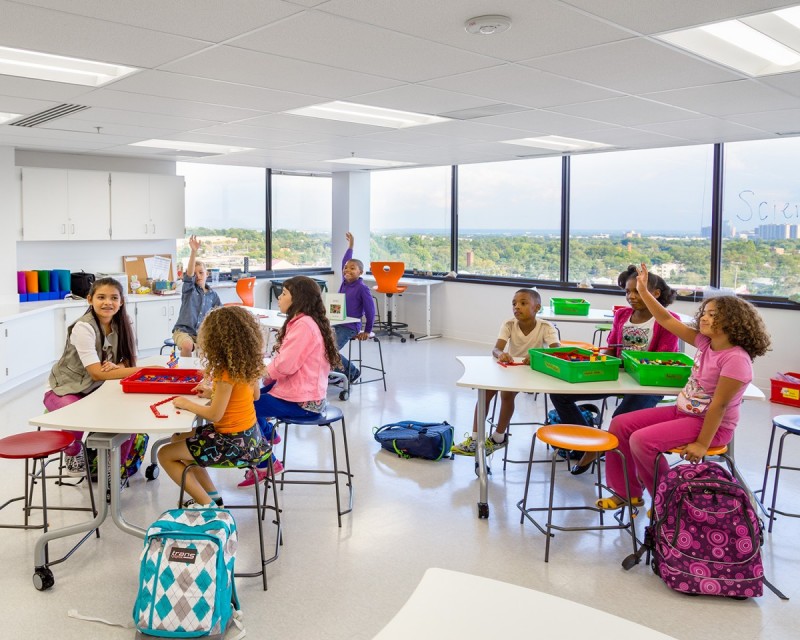
Obsolete office buildings in this area have also found new life as institutional and industrial facilities: a public school in Baileys Crossroads, a private school in Tysons, and as a self-storage facility in Rockville. These may be more appropriate reuse scenarios for low-rise buildings with deeper floors.
Crystal Mall 3, on Google Street View Image by the author.
In other cases, demolition may be the most efficient way to reuse a site — if a new use will cover the high costs. The Mall 3 tower in Crystal City, just a block east of the Metro entrance at 1851 S. Bell Street, is awkwardly configured: 130 feet deep, with little parking courts at each corner. Bringing new offices or apartments to the site would require such intensive reconfiguration that it’s easier to start from scratch with narrower and taller towers closer to the streets, whether office (as was proposed in 2012) or dual residential towers (as a future plan proposes.)
Similarly, large-scale new developments around Tysons are demolishing old buildings that stand in the way not just of new structures, but also new streets and parks that will better knit the urban fabric together.
Of course, offices aren’t disappearing from our region anytime soon, so the best use for many office buildings will continue to be offices — but perhaps surrounded by different, complementary uses instead of lawns and parking lots. For instance, new townhouses sit right across the street from the soon-to-be-vacated Marriott headquarters in Montgomery County. RTC West, southwest of Reston Town Center, has added several new restaurants and retailers — both within an existing office building and in a new wing that replaced a lawn.
